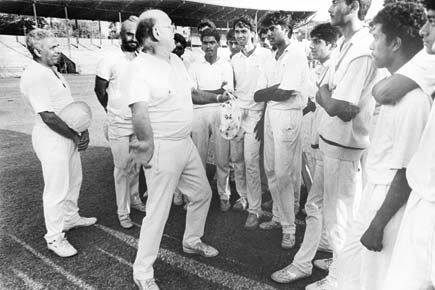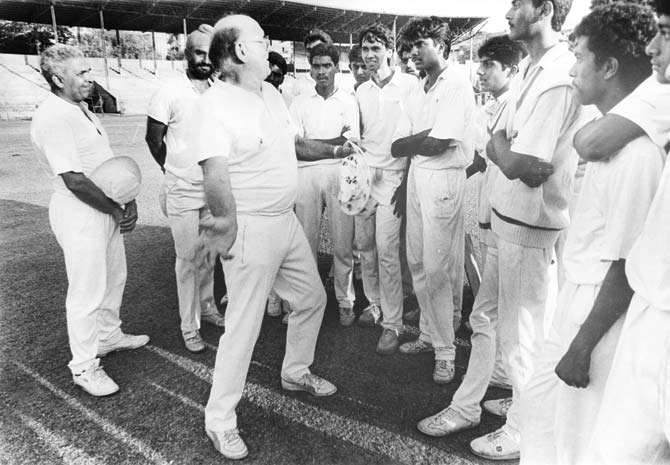A few evenings ago, the Mumbai Cricket Association (MCA) sent out a press release to announce a talent hunt scheme among tennis ball bowlers in the age group of 16 to 19

 A few evenings ago, the Mumbai Cricket Association (MCA) sent out a press release to announce a talent hunt scheme among tennis ball bowlers in the age group of 16 to 19.
A few evenings ago, the Mumbai Cricket Association (MCA) sent out a press release to announce a talent hunt scheme among tennis ball bowlers in the age group of 16 to 19.
ADVERTISEMENT
The first selection trials kick off for Thane cricketers today, while the trials for city cricketers are yet to be announced.
How serious is the MCA about unearthing fast bowlers? Is this talent hunt merely a pre-election exercise? Or is this the start of something big just like the Bombay Cricket Association-Mafatlal Bowling Scheme (not for tennis ball bowlers though), which impacted Mumbai cricket in the early 1990s? These are questions that cross one’s mind, and the answers will emerge only with the passage of time.

Former England fast bowler Frank Tyson coaching young bowlers from the BCA-Mafatlal Bowling Scheme at Brabourne Stadium in 1991. To Tyson’s left are coaches Balvinder Singh Sandhu and Kenia Jayantilal (extreme left). Pic/mid-day archives
The initiative should be welcomed but its success will depend on the right kind of personnel and a high degree of efficiency as well as commitment among cricket officials.
There is good reason to be pessimistic about Mumbai cricket. The prevailing system has contributed to this feeling, and the cricket fraternity continues to moan about the huge dip in standards.
Was there a better way of announcing the scheme than through a mere press release? Yes. If the MCA felt it would hurt their coffers by releasing advertisements in leading newspapers, inviting tennis ball bowlers to turn up for the selection trials, they could have organised a press conference which would project a thorough plan along with the names of selectors, talent scouts and coaches at their Bandra-Kurla Complex academy, where the selected boys will be ultimately coached.
A vibrant, dynamic approach will be needed if fast bowling talent is to be discovered from tennis ball hurlers.
Makarand Waingankar, the journalist and cricket consultant, who was chief coordinator of the BCA-Mafatlal Bowling Scheme in 1990, remembers advertisements released in English and Marathi newspapers about that scheme, which was spread across several grounds in the city and beyond.
Former Test captain Nari Contractor, the overall head and then employed with Mafatlal, visited England to find a suitable head coach. A few former England fast bowlers and reputed coaches got interested in the scheme, but when Contractor noticed they didn’t have a clear-cut plan, he didn’t pick them. He ultimately chose Frank Tyson, and it was a masterstroke!
Tyson and the scheme became a big part of Mumbai cricket. We were told that he was very keen on his bowlers playing on good surfaces as well. Paras Mhambrey, who represented Sunder Cricket Club at Cross Maidan from 1989 to 1991, was soon representing Cricket Club of India along with his scheme mates, Salil Ankola and Abey Kuruvilla.
The BCA-Mafatlal Bowling Scheme caused a revolution in Mumbai cricket. Ankola, who shifted from Maharashtra to Mumbai, ended up wearing India colours again in 1993 after his debut tour to Pakistan in 1989. Even club bowlers who were not produced by the programme wanted to train with Tyson.
Probably, the crowning glory of the scheme was in 1993-94, when Mumbai got their hands on the Ranji Trophy after nine years as Kuruvilla, Ankola, Mhambrey and leg-spinner Sairaj Bahutule formed Shastri’s bowling attack.
Unfortunately, the scheme was disbanded due to shortage of grounds, however unbelievable that sounds in the city of Mumbai. But it left a legacy. In fact, the closure was one of the reasons for Dilip Vengsarkar setting up his academy at the Oval Maidan in 1995. He said then: “I wanted to do something to sort of take off from the Mafatlal Scheme, which I thought was a great concept and very unfortunately had to come to a halt.”
In many ways, Kuruvilla represented the success of the scheme. The story goes that he was forced to attend a University selection trial by his college principal in December 1990. He bowled a few balls, which went over the net and, as expected, wasn’t picked. However, Waingankar, who watched Kuruvilla’s deliveries from the pavilion end of the Wankhede Stadium, was impressed by his pace and wanted Kuruvilla to be part of
the scheme.
Kuruvilla politely told Waingankar that he was not only disinterested in cricket, but was also getting late for a movie. After taking down Kuruvilla’s number on his left palm, Waingankar called to convince him to join the scheme that evening.
By May 1991, Kuruvilla was playing the Ranji Trophy final for Mumbai against Haryana. Incidentally, today is the 24th anniversary for that thriller, which Haryana won by two runs.
Clayton Murzello is mid-day’s Group Sports Editor
 Subscribe today by clicking the link and stay updated with the latest news!" Click here!
Subscribe today by clicking the link and stay updated with the latest news!" Click here!






